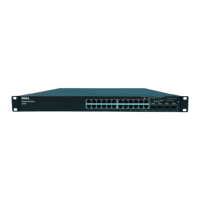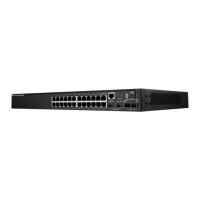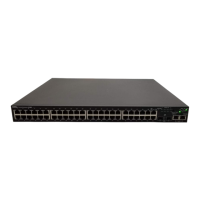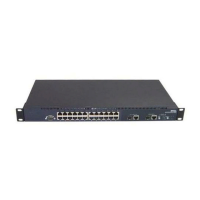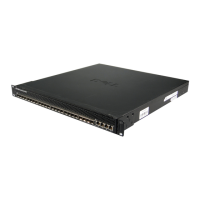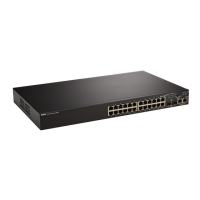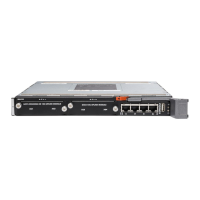
Do you have a question about the Dell PowerConnect M6220 and is the answer not in the manual?
| MAC Address Table Size | 32000 entries |
|---|---|
| Jumbo Frame Support | Yes |
| Device Type | Switch |
| Enclosure Type | Rack-Mountable |
| Routing Protocol | OSPF, RIP, BGP |
| Remote Management Protocol | SNMP 1, RMON 1, RMON 2, RMON 3, RMON 9, Telnet, HTTP, CLI |
| Features | Flow control, DHCP support, BOOTP support, ARP support, VLAN support, trunking, port mirroring, Quality of Service (QoS), Jumbo Frames support, LLDP support |
| Compliant Standards | IEEE 802.1Q, IEEE 802.3 |
| Power Supply | Redundant Power Supply |
| Operating Temperature | 32 to 113 °F |
| Operating Humidity | 10 to 90% non-condensing |
| Capacity | Virtual interfaces (VLANs): 4094 |
Describes the structure and organization of the document's content.
Lists related documents that provide further information on the switch software.
Explains how to discover network routes packets take to a destination.
Allows generating, uploading, and applying text-formatted configuration scripts to switches.
Establishes an outbound telnet connection between a device and a remote host.
Synchronizes network resources and provides a consistent network timestamp.
Allows storing system messages and/or errors on local or remote servers.
Specifies an alphanumeric interface identifier for SNMP network management.
Protects against traffic storms by dropping excess broadcast, multicast, or unicast traffic.
Determines cable connection status and characteristics using Time Domain Reflectometry (TDR).
Partitions a network into logical segments, improving administration and security.
Determines VLAN membership based on host IP or MAC address, not port.
Prevents ports within a group from forwarding traffic to each other, enhancing security.
Monitors IGMP transactions to conserve bandwidth by forwarding multicast traffic selectively.
Manages IGMP snooping functions on VLANs without requiring an IP multicast router.
Treats multiple physical links as a single logical link for increased bandwidth and reliability.
Selects network traffic from specific ports for analysis by a network analyzer.
Limits the number of MAC addresses that can be learned on a given port.
Allows interfaces to advertise capabilities and physical descriptions for network topology identification.
Protects the network and switch against various types of Denial of Service (DoS) attacks.
Provides security by filtering untrusted DHCP messages to prevent unauthorized servers.
Minimizes administration for managing switch blades by mapping internal to external ports.
Lists CLI commands available in Simple mode for Port Aggregator configuration.
Configures the switch to support routing between different VLANs.
Provides a backup routing mechanism using VRRP to eliminate single points of failure.
Allows a router to answer ARP requests for destinations it can reach.
Open Shortest Path First protocol for efficient routing in large and complex networks.
An interior gateway protocol used for exchanging network topology information.
Controls how the router chooses routes by assigning administrative preference values.
Allows the router to use multiple next hops for the same destination for load balancing.
Manages software-only interfaces for stable IP addressing and device management.
Controls port access by enforcing authentication of supplicants.
Assigns hosts to specific VLANs based on the results of 802.1X authentication.
Provides distinguished network service to unauthenticated users or visitors.
Allows external servers to assign DiffServ policies to authenticated users.
Defines rules to permit or deny network access and control traffic flow.
Layer 2 ACLs used to inspect packet fields like MAC addresses and Ethertypes.
Layer 3/4 ACLs used to classify and control inbound traffic based on IP and port information.
Remote Authentication Dial In User Service protocol for centralized authentication.
Terminal Access Controller Access Control System for networked device access control.
Introduces IPv6 network operation, addresses, and packet formats.
Enables and configures IPv6 on physical and VLAN interfaces for routing.
Assigns IP addresses, gateways, and other network definitions for IPv6 clients.
Provides preferential traffic treatment by configuring ingress/egress ports and queues.
Configures ports as trusted/untrusted and maps traffic to CoS queues.
Specifies port shaping rates to control maximum transmission bandwidth.
Implements QoS policies by classifying traffic based on IP header information.
Enables sending IP datagrams to multiple destinations simultaneously for efficient bandwidth use.
Manages multicast group membership information for IPv4 hosts and routers.
Enables learning membership and forwarding multicast packets without full multicast routing protocols.
Distance Vector Multicast Routing Protocol for constructing multicast distribution trees.
Protocol Independent Multicast for scalable inter-domain multicast routing.
PIM Dense Mode protocol for efficient routing to densely distributed receivers.
